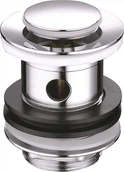Hey there! As a cup washer supplier, I often get asked about the difference between a cup washer and a spring washer. It might seem like a small detail, but these two types of washers have distinct features and uses. So, let's dive right in and break it down.
What's a Cup Washer?
First off, let me tell you about cup washers. A cup washer, also known as a conical washer, has a unique shape. It looks like a little cup, with one side being flat and the other curved. This shape gives it some pretty cool properties.


One of the main uses of cup washers is in applications where you need to distribute the load evenly. When you tighten a bolt or a screw, the cup washer spreads the pressure over a larger area. This helps prevent damage to the surface you're fastening to. For example, if you're attaching a piece of metal to a wooden board, a cup washer can stop the screw from digging into the wood and causing it to split.
Cup washers are also great for providing a tight seal. The curved side of the washer can conform to the surface, creating a barrier that keeps out moisture, dirt, and other unwanted stuff. This makes them ideal for outdoor applications or in environments where you need to protect your fasteners from corrosion.
I'm a big fan of cup washers because they're so versatile. You can find them in all sorts of sizes and materials, like stainless steel, brass, and plastic. Depending on your specific needs, you can choose the right cup washer for the job. And if you're looking for some cool cup - related products, check out Sink Cup Rinser, Bottle Rinser For Sink, and Cup Rinser in Sink.
What's a Spring Washer?
Now, let's talk about spring washers. A spring washer is designed to provide a spring - like action. It has a split or a wave pattern that allows it to compress and expand.
The main purpose of a spring washer is to prevent loosening. When you tighten a bolt or a nut, the spring washer creates a constant tension. This tension helps keep the fastener in place, even when there's vibration or movement. For example, in a machine that vibrates a lot, like a car engine or a washing machine, a spring washer can stop the bolts from coming loose over time.
Spring washers are also used to compensate for any slight changes in the joint. If the materials you're fastening expand or contract due to temperature changes, the spring washer can adjust and maintain the clamping force.
However, spring washers have their limitations. They might not be as effective in distributing the load as cup washers. And in some cases, if the vibration is too strong, the spring washer might lose its tension and stop working properly.
Key Differences
- Shape and Design: The most obvious difference is the shape. Cup washers are conical, with a flat and a curved side. Spring washers have a split or a wave pattern that gives them their springy action.
- Function: Cup washers are mainly for load distribution and sealing. They spread the pressure and keep out contaminants. Spring washers are focused on preventing loosening and compensating for joint changes.
- Application: Cup washers are great for applications where you need a tight seal and even load distribution, like in outdoor structures or plumbing. Spring washers are commonly used in machinery and equipment that experience vibration.
- Material and Durability: Both can be made from various materials, but the choice often depends on the application. Cup washers made of stainless steel are very durable and resistant to corrosion, which is great for long - term outdoor use. Spring washers need to have good spring properties, so materials like high - carbon steel are often used.
Which One to Choose?
Deciding between a cup washer and a spring washer depends on your specific needs. If you're dealing with a surface that's prone to damage from the fastener, or if you need to create a seal, a cup washer is probably the way to go. On the other hand, if you're in an environment with a lot of vibration and you need to prevent loosening, a spring washer is a better choice.
In some cases, you might even use both together. For example, you could use a cup washer to distribute the load and a spring washer to prevent loosening. This combination can provide the best of both worlds.
Why Choose Our Cup Washers?
As a cup washer supplier, I can tell you that our cup washers are top - notch. We use high - quality materials and advanced manufacturing processes to ensure that our products meet the highest standards.
Our cup washers come in a wide range of sizes and materials, so you can find the perfect one for your project. Whether you need a small cup washer for a delicate job or a large one for heavy - duty applications, we've got you covered.
We also offer great customer service. If you have any questions about our cup washers or need help choosing the right one, our team is always here to assist you.
Let's Connect!
If you're interested in our cup washers or have any questions about the difference between cup washers and spring washers, don't hesitate to reach out. We're always happy to talk about our products and help you find the best solution for your needs. Whether you're a DIY enthusiast or a professional in the industry, we can provide you with the cup washers you need.
References
- "Handbook of Fastening Technology," various authors
- "Mechanical Design Handbook," edited by Myer Kutz





